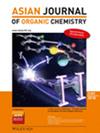l -苏糖醇衍生的手性氮冠醚的构效关系及可重复使用性
IF 2.7
4区 化学
Q1 CHEMISTRY, ORGANIC
引用次数: 0
摘要
在对映选择性反应中,可以使用几种催化剂,例如手性冠醚,它可以形成一组特殊的冠醚。除了反应条件外,所用催化剂的结构也会影响反应的结果。以碳水化合物为基础的冠醚为例,我们之前发现单氮-15-冠-5结构是最有效的,产生的对映体过量受氮取代基、碳水化合物的保护基团和手性来源的影响。本研究以l-苏糖醇为原料合成了具有相似结构的大环,并与已有化合物在不同的模型反应中进行了催化活性和可重复使用性的测试和比较。指出了几种类型的效应-结构关系,而对映体过量变化很大。我们证明了冠醚的可恢复性通过酸性提取和随后的解放氮冠部分。在放大反应中对再生过程进行了更彻底的研究,其中催化剂的选择性保留了三个检查循环。本文章由计算机程序翻译,如有差异,请以英文原文为准。

The Structure‐Activity Relationship and Reusability of Chiral Azacrown Ethers Derived from L‐Threitol
In enantioselective reactions, several catalysts can be used, such as chiral crown ethers, which form a special group of them. In addition to the reaction conditions, the structure of the catalyst used also affects the outcome of the reaction. In the case of carbohydrate‐based crown ethers, we previously found that the monoaza‐15‐crown‐5 structure is the most effective, and the generated enantiomeric excess is influenced by the substituent of the nitrogen, the protecting groups of the carbohydrate, and the source of chirality. In this study, macrocycles derived from l‐threitol were synthesized with a similar structure, and their catalytic activity and reusability were tested and compared in different model reactions along with some previously prepared compounds. Several types of effect‐structure relationships were pointed out, while the enantiomeric excess varied widely. We demonstrated the recoverability of the crown ethers by acidic extraction and subsequent liberation of the azacrown moiety. The regeneration process was investigated more thoroughly in scaled‐up reactions, where the selectivity of the catalysts preserved for three examined cycles.
求助全文
通过发布文献求助,成功后即可免费获取论文全文。
去求助
来源期刊

Asian Journal of Organic Chemistry
CHEMISTRY, ORGANIC-
CiteScore
4.70
自引率
3.70%
发文量
372
期刊介绍:
Organic chemistry is the fundamental science that stands at the heart of chemistry, biology, and materials science. Research in these areas is vigorous and truly international, with three major regions making almost equal contributions: America, Europe and Asia. Asia now has its own top international organic chemistry journal—the Asian Journal of Organic Chemistry (AsianJOC)
The AsianJOC is designed to be a top-ranked international research journal and publishes primary research as well as critical secondary information from authors across the world. The journal covers organic chemistry in its entirety. Authors and readers come from academia, the chemical industry, and government laboratories.
 求助内容:
求助内容: 应助结果提醒方式:
应助结果提醒方式:


